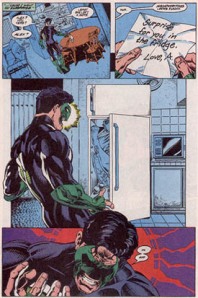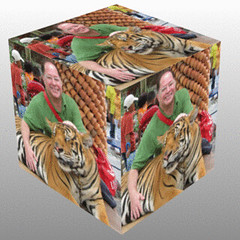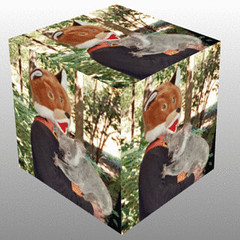The Women in Refrigerators term was created by Gail Simone. The name women in refrigerators derives from an event in Green Lantern #50 in which Kyle finds his dead girlfriend stuffed into a refrigerator. The comic book page involved can be seen below.
Simone and friends created an online list on a web site of the same name. The list details comic book female characters that have been killed, raped, depowered, crippled, turned evil, maimed, tortured, contracted a disease, or had other life-derailing tragedies. The project’s list was found at:
http://www.unheardtaunts.com/wir/women.html
The list used for this study was downloaded on February 24, 2010 from the mentioned site. The downloaded list below has been altered significantly from the original for the purpose of this study. The purpose of this study is to see if DC or Marvel had more characters on the list. I removed all names of characters that are not properties of DC or Marvel. I then divided the list into two categories: DC and Marvel. The list with divisions is in the appendix at the end of this article. I then counted the number of DC characters on the list as opposed to the number of Marvel characters on the list.
Results
DC had 59 characters on the list. Marvel had 43 characters on the list. DC had 16 more characters on the list than Marvel. DC had a little more than one-third more characters on the list than Marvel. I also counted the number of rapes and tortures in each list. The instances of rape and torture are highlighted on the list in the appendix. DC had one rape (Starfire) versus none for Marvel. DC had three instances of torture (Black Canary II, Domino, Starfire) compared to none for Marvel. This means that not only DC’s total but subtotal of more horrific events was greater than that of Marvel.
Conclusion
The data suggests that DC has a more sexist editorial policy towards its female characters than Marvel. Parents should be made aware of this potential sexist bias in DC comics and consider not buying DC comic books or giving their products special scrutiny in the case of juveniles. I would say this is particularly true if the parents have young daughters who are at an impressionable age.
I personally do not support governmental censorship and feel this is a responsibility appropriately given to parents. Parents already use channel blockers for television. Parents use software programs to monitor the internet usage of their children. Comic books require a more low-tech approach. Parents should at least occasionally skim the comic books their children read. The realization that one comic book company may be more prone to a sexist bias than another and that company may deserve special scrutiny, should make the job of parents easier.
There are several limitations to this study. The list may be flawed and have errors of inclusion or exclusion. However, the list is the result of many hours of work of many online participants and is probably a fairly accurate list.
A more serious limitation of this study is the need not to just monitor total events, quantity, but how horrific events are, quality. What constitutes a horrific event for a comic book character has a subjective side above and beyond total numbers. For example, depowerment, taking away the super powers of a character, is an event that often happens in comic books but I would think has very little relevance or emotional impact precisely due to its fantastic nature. Rape and torture probably will have a much greater impact on the psyche of juveniles. A depowered character is counted equally with a raped and/or tortured character on this list despite the fact the two events probably have very different levels of emotional impact on young readers.
I would further suggest that rape and torture have a particularly visceral impact even compared to murder especially compared with comic book murder, which is almost clinical compared to its TV or movie counterpart. Comic book murders generally do not show much blood and more is left to the imagination than shown. Comic books are not just a textual medium but a visual medium as well. I am an avid comic book fan and have read many of the events on the list. Textually two events may seem equal on the list but the graphic depiction of the event has a radically different psychological impact depending on the portrayal of the event. This graphic effect is not measured by the textual nature of the list.
There is some good news in this study. I could only find only one instance of rape on the list! The depictions of torture are also relatively rare. I could only find three instances of torture on the list. Compared to other media such as TV and movies this number is extremely small and this would suggest as a media there is an attempt by both comic book companies to make comic books juvenile friendly.
Other DC vs. Marvel Posts
Check out my other website at:
Appendix
| DC – Amethyst (blinded, merged with Gemworld, destroyed in LSH; became a power-hungry witch in Book of Fate) | |
| DC – Apparition (one of her three bodies dead, soul bound to boyfriend) | |
| DC – Aquagirl (dead) | |
| DC – Arisia (dead) | |
| DC – Batgirl I (paralyzed) | |
| DC – Batwoman (dead) | |
| DC – Black Canary I (dead) | |
| DC – Black Canary II (tortured, made infertile, depowered) | |
| DC – Buf from X-Man (crippled) | |
| DC – Carol Ferris/Star Sapphire (turned into a villain by the Zamarons, possessed by the Predator) | |
| DC – Celsius (insane, dead, called delusional liar) | |
| DC – Crimson Fox (both sisters dead) | |
| DC – Dawn Allen (dead) | |
| DC – Dawnstar (wings cut off, possessed by another persona) | |
| DC – Domino (kidnapped, tortured) | |
| DC – Dove II (dead) | |
| DC – Dr. Midnight of Infinity, Inc. (dead) | |
| DC – Elasti-Girl (only original Doom Patroller to stay dead) | |
| DC – Element Girl (dead) | |
| DC – Enchantress of Suicide Squad – originally a heroine (turned evil, insane, depowered?) | |
| DC – Frances Kane/Magenta (stalker complex) | |
| DC – Fury II (child kidnapped, husband killed twice, insane) | |
| DC – Hawkwoman (depowered) | |
| DC – Huntress I (dead) | |
| DC – Huntress II (sexually abused) | |
| DC – Jade (lost natural powers) | |
| DC – Jean Loring Palmer (“nervous breakdown”) | |
| DC – Katma Tui (dead) | |
| DC – Kinetix (depowered twice, catatonic) | |
| DC – Kole (dead) | |
| DC – Lady Flash (evil, dead) | |
| DC – Lady Quark (dead) | |
| DC – Laurel Gand (dead) | |
| DC – Laurel Kent (revealed to be an evil robot, dead) | |
| DC – Linda Park (kidnapped, removed from history) | |
| DC – Looker (now a vampire) | |
| DC – Mentalla of LSH (dead) | |
| DC – Mera (insane, child murdered) | |
| DC – Mirage of Team Titans (impregnated by rape) | |
| DC – Mrs. Brian Banner, Bruce’s mother (murdered by her abusive husband) | |
| DC – Mystek of JLTF (dead) | |
| DC – Negative Woman (depowered) | |
| DC – Nightshade (depowered) | |
| DC – Nightwind (dead) | |
| DC – Power Girl (depowered, magically impregnated, made vulnerable to unprocessed natural materials… like sharp sticks) | |
| DC – Raven (sometimes evil, sometimes dead) | |
| DC – Redwing of Team Titans (dead) | |
| DC – Shrinking Violet (lost a leg in Giffen’s Legion) | |
| DC – Shvaughn Erin (turned into a man) | |
| DC – Silver Sorceress (dead) | |
| DC – Starfire (raped, tortured, enslaved; forced into marriage… twice) | |
| DC – Supergirl, PAD version (lost her invisibility and most of her shapeshifting) | |
| DC – Supergirl, pre-Crisis (dead) | |
| DC – SW6 Projectra (dead) | |
| DC – Triplicate Girl (one body killed, one presumed dead but revealed to be Glorith’s pawn) | |
| DC – Wildcat II (dead) | |
| DC – Wonder Girl I/Troia/Darkstar (identity and powers stripped from her multiple times) | |
| DC – Wonder Woman (killed, revived, but lost goddess powers) | |
| DC – Zatanna (powers severely limited) | |
| Marvel – Alysande Stuart (dead) | |
| Marvel – Aurora (Multiple Personality Disorder, depowered) | |
| Marvel – Betty Banner (abused, changed into a harpy, multiple miscarriages, dead) | |
| Marvel – Blink (dead) | |
| Marvel – Bluebird (dead) | |
| Marvel – Candy Southern (dead) | |
| Marvel – Captain Marvel II/Photon (depowered, ceded code name to a male hero) | |
| Marvel – Courtney Ross (dead) | |
| Marvel – Diamond Lil (kidnapped, experimented on by own government, developed benign breast tumor) | |
| Marvel – Elektra (the real one… dead) | |
| Marvel – Firestar (powers were sterilizing her) | |
| Marvel – Gwen Stacy (dead) | |
| Marvel – Hellcat (dead) | |
| Marvel – Illyana Rasputin (kidnapped and raised by demons, aged, de-aged, dead) | |
| Marvel – Invisible Woman (miscarriage of second child) | |
| Marvel – Jarella (dead) | |
| Marvel – Jean DeWolff (dead) | |
| Marvel – Jet of New Guardians (died in battle after contracting HIV) | |
| Marvel – Jocasta (deactivated – more than once) | |
| Marvel – Karen Page (addicted to drugs, made porn films, infected with HIV, dead) | |
| Marvel – Madelyn Pryor (clone, brood mare, demon queen, dead, brought back) | |
| Marvel – Mantis (child taken away, dead) | |
| Marvel – Marlo Chandler — Rick Jones’ wife (former prostitute, killed and brought back mindless; got better) | |
| Marvel – Marrina (insane, dead) | |
| Marvel – Mockingbird (abducted and mind-manipulated into a relationship, dead) | |
| Marvel – Moira MacTaggert (diseased) | |
| Marvel – Ms. Marvel I/Warbird (mind-controlled, impregnated by rape, powers and memories stolen, cosmic-powered then depowered, alcoholic – SHEESH!) | |
| Marvel – Ms. Marvel II (became a monster in Fantastic Four, de-monstered but enslaved by Dr. Doom, depowered) | |
| Marvel – Namorita (revealed to be a clone, reverted to a more primal Atlantean form) | |
| Marvel – Nova II/Frankie Raye (dead) | |
| Marvel – Phoenix I (evil-dead-who knows) | |
| Marvel – Psylocke (eyes removed, eviscerated, depowered, mind-swapped) | |
| Marvel – Rachel Summers/Phoenix II (lobotomized) | |
| Marvel – Red Guardian II (kidnapped and brainwashed into the love-slave of a super-villain) | |
| Marvel – Revanche (dead) | |
| Marvel – Rogue (just plain messed up) | |
| Marvel – Roulette (dead) | |
| Marvel – Scarlet Witch (children ‘die’/vanish/are lost because they are figments of her imagination) | |
| Marvel – Snowbird (child and husband murdered, insane, dead) | |
| Marvel – Spider-Woman I (dead for a while, depowered) | |
| Marvel – Storm (depowered, repowered, periodically crazy to one degree or another) | |
| Marvel – Threnody (dead) | |
| Marvel – Tigra (devolved into cat-thing) | |
| Marvel – Wolfsbane (locked in werewolf form for awhile, needs major therapy) | |
WereVerse Universe Baby!












Interesting post, Hugh. Comic book violence towards women is something I have never considered before. Another factor we might want to look at is the nature of the violence, and its source – does the violent act happen to the female character because the antagonist is evil, or is it a gratuitous act of violence inflicted randomly, arbitrarily so far as the plot of the comic book is concerned. That is, how many of these violent acts can be attributed to a bad guy, and how many can be attributed directly to the vicious whims of the author!?
I totally agree that gratuitous violence is worse than violence that logically follows from plot development. I think part of the Women in Refrigerators Syndrome argument is that violence towards female characters is more gratuitous than violence directed towards male characters. There is also a Males Defrosting argument that violence towards male characters leads to the character being empowered. Batman has his back broken by Bane but comes back stronger than ever.
Interesting but one flaw in the data. How many female characters are there in DC compared to Marvel. If a lot more, then the high figure of your stats donlt mean much but if lower, then it would support your hypothesis that DC is more violent towards women.
Excellent point! I would have to add your caveat as yet another limitation of the study. Even if the total number of DC and Marvel female characters were the same then this would not solve the problem you mention. Many of the characters on the list are very minor ones. The impact of the death, torture or rape of a major character is much more important. Minor characters in comic books can be very minor indeed. I would say a horrific event in the plot line of a major character like Wonder Woman would be ten times more relevant than some of the very minor characters on the list. This year both Batman and Captain America were killed off! How do the deaths of the first tier characters that have been around for fifty plus years compare to the death of lets say Candy Southern that is on the list and whose value is not somehow weighted? Frankly, I had to look up Candy Southern and a lot of the other characters on the list and I think I know more about DC and Marvel characters than most. Its quite simply an apples and oranges issues. You can say the death of Captain America counts as much as the death of Candy Southern but this is not the case logically. Number of appearances would one way to weight characters. The Comic Vine website does provide this measure!
For the record both DC and Marvel have thousands of characters not hundreds and even the companies themselves will quote wildly different numbers when describing how many characters they have. What I am trying to point out is that the number of female characters per company is not easy task. You could only count the characters in official company universe publications or perhaps the DK Encyclopedias of each company but even these sources change who is counted or not counted year by year. I do think comic books have a sexist bias above and beyond this list and this study and wonder if that sexist bias would extend to the universe publications or the DK Encyclopedias. I think there would be tendency to undercount female characters in both these publications. You have to make some sort of operational criteria as to who gets counted and how that would actually have to be fairly complicated. You would also need to create some sort of weighting system.
Another problem with the study is that it assumes that, in a medium rife with evil deeds, an act of violence on a female character is sexist. DC committed acts of violence on 59 female characters. How many male characters suffered similar acts? What’s the ratio of male to female characters? Did a proportionally larger number of female characters suffer violence? Only if females are disproportionately represented can any argument of sexism be made.
I would say that female characters are in fact a lot less often the victims of violence and torture, because writers don’t want to put that in their books. If you torture Wolverine, no one cares. Torture Black Canary and the world is up in arms about sexist portrayals. Superman was just being tortured by Lex Luther this week, in fact, and all anyone is complaining about is a little skin in the Catwoman book. If you have a female star of a book, and she fights evil people month after month, something bad is bound to happen to her eventually.
Comics have evil characters committing violence and heroic characters trying to stop them. If you put on a costume and go out to fight crime, bad things may happen to you. They happen to real people too. If no female character was ever killed, maimed or assaulted, that would seriously misrepresent the real world.
I agree with your comments and want to go one step further. What really needs to be done with this study is a proper definition of the “population” studied. The population cannot be the number of male vs. female characters in a universe. The more correct number would be the number of times a character has appeared and Comic Vine has already done all the leg work. If we go over there we find that Squirrel Girl has appeared in 56 issues
http://www.comicvine.com/squirrel-girl/29-2488/
Wolverine has appeared 5769 issues
http://www.comicvine.com/wolverine/29-1440/
The number of issue appearances is the true number of the male and female populations since this measures the actual importance of this character in that comic book universe. Marvel could invent a 100 female characters overnight in response to charges of being sexist and this vote rigging would work if you only count characters but not if you count issue appearances. To be frank I have not been very motivated to do all this work since there has been a relative lack of interest in this article until this week! If the numbers go up as they often do once an article catches on then I might do a follow up study with a better defined population. I think such a study might yield interesting results. I suspect there will be a disparity between the number of male vs. female characters with there being more male characters. However, I think the real disparity would be in the issue appearance numbers! You then could work out a ratio between the number of appearances the male characters have and the number of acts of violence committed upon them broken down by types of violence. One argument in this area is that women do not just suffer violence but certain types of violence. The ratio would be a truer measure gender violence than the flat out number of violent incidents by gender. I do want to mention that the article is comparing DC and Marvel and the methodology used is adequate for this task. However, I do think there is a need for a more definitive study as outlined here. I would use Comic Vine as the definitive list and source of issue appearance data this would be a limitation of the study.
While I’m glad that this subject is being talked about by male comic book fans, I feel that the original author does this subject a disservice by not talking about the full implications of Women in Refrigerators. Its the presentation and context, really.
Take the only female Robin’s death. Tortured to death by Black Mask. Now, just on that one sentence alone, it’s bad. But that this short list doesn’t tell you is that her long, drawn out demise was practically torture porn. She was laid out in provocative, sexy, unrealistic poses, she didn’t struggle, didn’t have any lines of defiance, just expressions of pain and screaming. She didn’t go out like a hero, she went out like a faceless hostage and her pain and agony subverted by presenting her like a centerfold in Playboy. And then on top of it, she’s the only Robin to not have a memorial in the Batcave. A sickening, terrible death that exploited her for sexual stimulation and the authors don’t even have the decency to have Bats honor her memory.
Another example: Big Barda. The great, towering Amazonian brawler hero that was married to Mister Miracle and fought with DC’s Big Three. Her death was…being ambushed while she was at home, putting up groceries. Her husband finds her dead in the kitchen. IN. THE. KITCHEN. Tell me how it would look to have Batman killed in his bathroom or Flash in his closet. Its not heroic, and nothing comes of her death other than to motivate Mister Miracle. She didn’t even seem to put up a fight! http://dc.wikia.com/wiki/File:Death_of_Big_Barda_01.jpg Even her “death pose” is unreasonably erotic, sexualizing her death.
Its not that female heroes die or get hurt, its the fact that their demises are usually plot points and motivators for male heroes. Their deaths only have worth in how sexualized their suffering is and in the context to what they mean for male heroes. Their deaths are, to be blunt, lame. Not heroic. Shuffled aside and forgotten. They suffer indignities, the worst fates you can imagine, and…they remain this way. Which is why I think no discussion about WIF should be without a look at the Dead Men Defrosting trope, which puts the problems with WIF into a gruesome light.
Dead Men Defrosting is the brother trope to WIF. It’s almost similar to WIF in that it addresses violence and death visited to male supers. But where DMF diverges from WIF is both in the manner their deaths are presented and what happens after. Male supers die on the battlefield, or they make heroic sacrifices for the good of all. Their deaths are always dramatic, powerful, MEANINGFUL and impact multiple characters and are felt more strongly. They go out like heroes. And almost without exception, THEY COME BACK.
They come back stronger, more powerful, smarter, wiser, ready to kick the bad guys asses. Their resurrections are moments of triumph and strength. They are heralded as the heroes they’re meant to be. But all those female heroes that appeared on this list? They dont come back, they almost never get better. They remain broken, traumatized, and weak shells of their former glory. If they dont die, they remain depowered and often succeed their titles or power to a male replacement. They arent characters – they’re disposable plot devices to create ~DRAMA~ and then put in the trash. That’s the problem.
Great comments and I am totally in agreement with your description of the borderline gorn treatment of the female Robin. The problem is there is no easy way to measure such qualitative factors although they are absolutely relevant to the discussion. I do agree with you that there is not just a quantative disparity but a qualitative disparity.
I was unaware of the Robin incident. This was clearly an ergregious abuse, more because of how it was presented than what was actually done to her. Before we can wholly condemn the event, we have to ask, “what would have happened if it had been Tim Drake instead of Stephanie?” Would Black Mask have tortured and murdered him? If so, we can’t condemn the story element just because the victim happened to be female. The real problem is how it was sexualized in the art. The art turned this into some sort of sick erotic fantasy, involving a 16 year old child.
You kind of have to wonder what the guys at DC were smoking while this plot line played out. The Stephanie Brown death (female Robin) was not just about one issue. The marketing guys at DC decided there was a need for an action figure of her killer, the Black Mask complete with the power drill he used to torture her:


http://www.dccomics.com/dcdirect/?dcd=3101
Below are links to just some of the pics:
However!
The above stuff does pale in comparison with the gorn created in Japanese comic books that I ran into while I lived in Japan for six months. Incredible six floor comic book shops and each floor devoted to a different fetish. I was aware of this stuff before but to really realize the role of fetishism in Japanese comic books you need to go there. There is a certain ‘equality’ in Japanese comic books in that female fetishes are also catered to. There was one floor devoted to Boy Love comic books and that floor was filled with gals. Yes Japanese gals read comic books! There was a Gay Love floor that was filled with men. Apparently in Japan there is a distinction between BL and GL:
http://www.japanesegayart.com/?p=1688
Dominatrix comic books are in a special section but that section is filled with guys invariably. The womens floor and yes there is such a floor in a really big comic book store in places like Akihabara:
http://en.wikipedia.org/wiki/Akihabara
mostly had cartoon type stuff but very cute compared to US toons, and romance type mags. The BL floor is generally a different floor. I kind of wished that I could read Japanese. The stuff that gets to the US in English nt of one percent of one percent of total output in Japan!
Sound great! I went ahead and Googled Trevor Von Eeden and read that he did a graphic novel about the boxer Jack Jackson in addition to his more mainstream work. Sounds really interesting. I do like to see stuff being created that breaks out of the super hero genre box. One of the great intercultural comic book mysteries is why Japanese comic books are in every genre possible and possibly even have more genres than even their cinema while comic books in the US are almost exclusively super hero titles. Keep in mind I have been living in Asia for the last 12 years so Asia is near while its the US thats far away from me culturally despite being an American.
As for the discussion about the inequality if female character death, that actually is relevant to my own comic I’m putting out online later this month.
The title character, Stalker, is female. http://www.gatewaycomicsonline.com. Her mother was the original Stalker, who was murdered. The daughter takes on her mother’s identity as a way to keep her mother alive in some way. The daughter is most respects, a stronger, better, changed Stalker, strengthened and inspired by her mother’s heroism and death.
As for her mother’s death, her last act is to fight for her daughter’s life.
Sounds like a great story line! This is an example of how a tragedy empowers the heroine and this is not the sort of tragic event that is at the center of the Women in Refrigerators debate. One of my current favorite favorite publishers is Boom Studios
http://www.boom-studios.com/
and the way violence is handle by the Plutonian in his title Irredemable is interesting in that a lot of male characters suffer the sort of violence that is associated with female characters in the Women in Refrigerators debate. I am in Thailand and the chances of me running into your title on a newstand are pretty much zero. If you email me a pdf copy at foxhugh@yahoo.com then I will be more than happy to review your first issue. I get about 600 hits a day and an awful lot of the people that read my blog are comic book fans. Can’t hurt!
Except that murder of a loved one as backstory/motivation is the oldest trope in the book. See Spiderman for details. However, as the saying goes “a good author borrows, a great author steals”. You are mixing up the trope by giving the mother an identity and face, and making her end a heroic one, so that’s a great start. My mind is already asking lots of questions with this premise, it sounds like its got some potential.
Your comment is of course addressed to Bradley. I have only created a comic book in my dreams. Batman is another character that springs to mind along the lines discussed. Batman was obviously more traumatized than Spider-Man. Bruce Wayne lost both parents vs. just Uncle Ben. Peter Parker was older than Bruce Wayne. Bruce Wayne saw the murder vs. seeing the body later. Also the Batman story also had details to the event that I think were mostly added later, in the Dark Knight, Bruce Wayne goes to the site were his parents were murdered and puts roses, and Bruce Wayne had just seen a Zorro film with his parents. Overall, I like the Batman backstory/motivation more than Spider-Man’s.
I’ll definitely do that, thanks. The book is being illustrated by Trevor Von Eeden (Black Lightning, Batman, Black Canary, Green Arrow, The Original Johnson). Trevor has completed the interior art, with just a couple pages still being inked (Page 1 pencils http://www.facebook.com/#!/photo.php?fbid=267118736634340&set=pu.243438395669041&type=1&theater). He’ll be doing the cover next week. Adrian Johnson is busy coloring. I’m the creator and writer. We also have some beautiful art by Sara Richard in the book (http://www.facebook.com/#!/photo.php?fbid=286620431350837&set=pu.243438395669041&type=1&theater). We expect to be mostly online, but I will have a limited print run for local shops, online ordering, cons and any retailers who choose to order from us.
Just checked out your web site and looks good!
Trevor has been great. He’s drawn some really beautiful pages for Stalker and has become very attached to her. Once we have a few colored pages, I’ll put more up on the website. Despite Earthquakes and Hurricaines and burst pipes and family crisises, he’s kept mostly on schedule.
He’s very proud of The Original Johnson as he wrote and illustrated it. Unfortunately, his publisher has failed to pay royalties and essentially stolen the book. He’s been fighting them for years now.
There’s a limited number of motivators for someone to decide to put on a funny costume and get shot at, especially if they don’t have super powers. Tragedy, resulting in rage (Batman) or guilt (Spider-Man) are good motivators. Stalker runs more along the rage/Batman line, and like Batman, witnesses the murder. She’s 14 at the time, 20 when we first see her in issue 1, putting her closer to Spider-man then Batman in age. Personality-wise? She’s more Nightwing than Batman.
We do get to know Stalker’s mom. The first issue is essentially her book, not her daughter’s. Trevor has actually threatened to start a bring back Ronnie campaign to save her, he’s become so attached (Stalker’s mom’s name is Veronica), and sends me nasty notes everytime he was to draw something relating to her death.
I like your origin story! There are certain conventions in comic books but you are definetly going into new territory. One character whose “motivation” I found interesting was Booster Gold. Booster Gold did it for the money and fame and actively went after corporate sponsors. The Smallville episode with Booster Gold wasn’t bad.
Woah! I’m really digging the template/theme of this website. It’s simple,
yet effective. A lot of times it’s hard to get that “perfect balance” between usability and appearance. I must say that you’ve
done a awesome job with this. Also, the blog loads extremely quick for me on Opera.
Exceptional Blog!
I like the minimalism of Coraline and it just works with my Banner which is actually a second generation banner:
https://foxhugh.wordpress.com/about-me/about-banner/
I cleaned up some alignment issues between the first and second banner but also worked on a different color pattern. B&W cube followed by a cube with color followed by another B&w cube to give more directionality to the banner. Thanks for the kind comments!